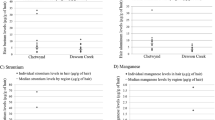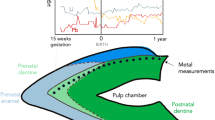Abstract
Dental amalgam is a mercury-based filling containing approximately 50% of metallic mercury (Hg0). Human placenta does not represent a real barrier to the transport of Hg0; hence, fetal exposure occurs as a result of maternal exposure to Hg, with possible subsequent neurodevelopmental disabilities in infants. This study represents a substudy of the international NIH-funded project “Early Childhood Development and polychlorinated biphenyls Exposure in Slovakia”. The main aim of this analysis was to assess the relationship between maternal dental amalgam fillings and exposure of the developing fetus to Hg. The study subjects were mother–child pairs (N=99). Questionnaires were administered after delivery, and chemical analyses of Hg were performed in the samples of maternal and cord blood using atomic absorption spectrometry with amalgamation technique. The median values of Hg concentrations were 0.63 μg/l (range 0.14–2.9 μg/l) and 0.80 μg/l (range 0.15–2.54 μg/l) for maternal and cord blood, respectively. None of the cord blood Hg concentrations reached the level considered to be hazardous for neurodevelopmental effects in children exposed to Hg in utero (EPA reference dose for Hg of 5.8 μg/l in cord blood). A strong positive correlation between maternal and cord blood Hg levels was found (ρ=0.79; P<0.001). Levels of Hg in the cord blood were significantly associated with the number of maternal amalgam fillings (ρ=0.46, P<0.001) and with the number of years since the last filling (ρ=−0.37, P<0.001); these associations remained significant after adjustment for maternal age and education. Dental amalgam fillings in girls and women of reproductive age should be used with caution, to avoid increased prenatal Hg exposure.
This is a preview of subscription content, access via your institution
Access options
Subscribe to this journal
Receive 6 print issues and online access
$259.00 per year
only $43.17 per issue
Buy this article
- Purchase on Springer Link
- Instant access to full article PDF
Prices may be subject to local taxes which are calculated during checkout


Similar content being viewed by others
References
Agency for Toxic Substances and Disease Registry. Toxicological Profile of Mercury 1999: http://www.atsdr.cdc.gov/toxprofiles/tp46.html.
Ask K., Åkesson A., Berglund M., and Vahter M. Inorganic mercury and methylmercury in placentas of Swedish women. Environ Health Perspect 2002: 110: 523–526.
Bates M.N., Fawcett J., Garrett J., Cutress T., and Kjellstrom T. Health effects of dental amalgam exposure: a retrospective cohort study. Int J Epidemiol 2004: 33: 894–902.
Bearer C.F. The special and unique vulnerability of children to environmental hazards. Neurotoxicology 2000: 21: 925–934.
Bjerregaard P., and Hansen J.C. Organochlorines and heavy metals in pregnant women from the Disko Bay area in Greenland. Sci Total Environ 2000: 245: 195–202.
Bjornberg K.A. Mercury exposure during early human development. Thesis, Institute of Environmental Medicine, Karolinska Institute, Stockholm 2005, 55pp.
Bjornberg K.A., Vahter M., Berglund B., Niklasson B., Blennow M., and Sandborgh-Englund G. Transport of methylmercury and inorganic mercury to the fetus and breast-fed infant. Environ Health Perspect 2005: 113: 1381–1385.
Bjornberg K.A., Vahter M., Petersson-Grawe K., Glynn A., Cnattingius S., Darnerud P.O., et al. Methyl mercury and inorganic mercury in Swedish pregnant women and in cord blood: influence of fish consumption. Environ Health Perspect 2003: 111: 637–641.
Clarkson T.W. The three modern faces of mercury. Environ Health Perspect 2002: 110: 11–23.
Counter S.A., and Buchanan L.H. Mercury exposure in children: a review. Toxicol Appl Pharm 2004: 198: 209–230.
Debes D., Budtz-Jorgensen E.B., Weihe P., White R.F., and Grandjean P. Impact of prenatal methylmercury exposure on neurobehavioral function at age 14 years. Neurotoxicol Teratol 2006: 28 (3): 363–375.
DeRouen T.A., Martin M.D., Leroux B.G., Townes B.D., Woods J.S., Leitao J., Castro-Caldas A., Luis H., Bernardo M., Rosenbaum G., and Martins I.P. Neurobehavioral effects of dental amalgam in children: a randomized clinical trial. JAMA 2006: 295: 1784–1792.
Dodes J.E. The amalgam controversy: an evidence-based analysis. J Am Dent Assoc 2001: 132: 348–356.
Drasch G., Schupp I., Hofl H., Reinke R., and Roider G. Mercury burden of human fetal and infant tissues. Eur J Pediatr 1994: 153: 607–610.
Drexler H., and Schaller K.-H. The mercury concentration in breast milk resulting from amalgam fillings and dietary habits. Environ Res (Section A) 1998: 77: 124–129.
Echeverria D., Aposhian H.V., Woods J.S., Heyer J.H., Aposhian M.M., Bittner A.C., Mahurin R.K., and Cianciola M. Neurobehavioral effects from exposure to dental amalgam Hg0: new distinctions between recent exposure and Hg body burden. FASEB J 1998: 12: 971–980.
Factor-Litvak P., Hasselgren G., Jacobs D., Begg M., Kline J., Geier J., et al. Mercury derived from dental amalgams and neuropsychologic function. Environ Health Perspect 2003: 111: 719–723.
Hertz-Picciotto I., Trnovec T., Kocan T., Charles M.J., Ciznar P., Lange P., et al. PCBs and early childhood development in Slovakia: study design and background. Fresenius Environ Bull 2003: 12: 208–214.
Hujoel P.P., Lydon-Rochelle M., Bollen A.M., Woods J.S., Geurtsen W., and del Aguila M.A. Mercury exposure from dental filling placement during pregnancy and low birth weight risk. Am J Epidemiol 2005: 161: 734–740.
Kingman A., Albers J.W., Arezzo J.C., Garabrant D.H., and Michalek J.E. Amalgam exposure and neurological function. Neurotoxicology 2005: 26: 241–255.
Koupilova I., Epstein H., Holcik J., Hajioff S., and McKee M. Health needs of the Roma population in the Czech and Slovak Republics. Soc Sci Med 2001: 53: 1191–1204.
Loftenius A., Englund G.S., and Ekstrand J. Acute exposure to mercury from amalgam: no short-time effect on the peripheral blood lymphocytes in healthy individuals. J Toxico Environ Health (Part A) 1998: 54: 547–560.
Lorscheider F.L., Vimy M.J., and Summers A.O. Mercury exposure from “silver” tooth fillings: emerging evidence questions a traditional dental paradigm. FASEB J 1995: 9: 504–508.
Mason H.J., Hindell P., and Williams N.R. Biological monitoring and exposure to mercury. Occup Med 2001: 51: 2–11.
Pizzichini M., Fonzi M., Giannerini F., Mencarelli M., Gasparoni A., Rocchi G., et al. Influence of amalgam fillings on Hg levels and total antioxidant activity in plasma of healthy donors. Sci Total Environ 2003: 301: 43–50.
Pleva J. Dental mercury — a public health hazard. Rev Environ Health 1994: 10: 1–27.
Ramirez G.B., Cruz C.V., Pagulayan O., Ostrea E., and Dalisay C. The Tagum Study I: Analysis and clinical correlates of mercury in maternal and cord blood, breast milk, meconium, and infant's hair. Pediatrics 2000: 106: 774–781.
Saxe S.R., Snowdon D.A., Wekstein M.W., Henry R.G., Rant F.T., Donegan S.J., et al. Dental amalgam and cognitive function in older women: findings from the nun study. J Am Dent Assoc 1995: 126: 1495–1501.
Takahashi Y., Tsuruta S., Arimoto M., Tanaka H., and Yoshida M. Placental transfer of mercury in pregnant rats which received dental amalgam restorations. Toxicology 2003: 186: 23–33.
Takahashi Y., Tsuruta S., Hasegawa J., Kameyama Y., and Yoshida M. Release of mercury from dental amalgam fillings in pregnant rats and distribution of mercury in maternal and fetal tissues. Toxicology 2001: 163: 115–126.
Ursinyova M., and Masanova V. Cadmium, lead and mercury in human milk from Slovakia. Food Addit Contam 2005: 22: 579–589.
Vahter M., Akesson A., Lind B., Bjors U., Schutz A., and Berglund M. Longitudinal study of methylmercury and inorganic mercury in blood and urine of pregnant and lactating women, as well as in umbilical cord blood. Environ Res 2000: 84: 186–194.
Vimy M.J., Takahashi Y., and Lorscheider F.L. Maternal–fetal distribution of mercury (203Hg) released from dental amalgam fillings. Am J Physiol Regul Integr Comp Physiol 1990: 258: 939–945.
Walker J.B., Houseman J., Seddon L., McMullen E., Tofflemire K., Mills C., et al. Maternal and umbilical cord blood levels of mercury, lead, cadmium, and essential trace elements in Arctic Canada. Environ Res 2006: 100: 295–318.
Weiner J.A., and Nylander M. The relationship between mercury concentration in human organs and different predictor variables. Sci Total Environ 1993: 138: 101–115.
WHO. Mercury, In: Air Quality Guidelines. 2nd edn., Chapter 6.9. WHO Regional Office for Europe, Copenhagen, Denmark, 2000.
WHO. Inorganic Mercury. Environmental Health Criteria 118. International Program on Chemical Safety (IPCS) 1991, World Health Organization: Geneva, Switzerland.
Acknowledgements
We express appreciation for the funding received from the US National Institutes of Health, National Cancer Institute, grant # R01-CA96525 and Fulbright grant # 12/06 FC.
Author information
Authors and Affiliations
Corresponding author
Rights and permissions
About this article
Cite this article
Palkovicova, L., Ursinyova, M., Masanova, V. et al. Maternal amalgam dental fillings as the source of mercury exposure in developing fetus and newborn. J Expo Sci Environ Epidemiol 18, 326–331 (2008). https://doi.org/10.1038/sj.jes.7500606
Received:
Accepted:
Published:
Issue Date:
DOI: https://doi.org/10.1038/sj.jes.7500606
Keywords
This article is cited by
-
Proficiency testing for total mercury in oyster with a metrologically traceable reference value from isotope dilution mass spectrometry: implications on laboratory practices using mercury analyzers
Accreditation and Quality Assurance (2019)
-
Prenatal and Early Postnatal Exposure to Total Mercury and Methylmercury from Low Maternal Fish Consumption
Biological Trace Element Research (2019)
-
Children’s Hair Mercury Concentrations and Seafood Consumption in Five Regions of Japan
Archives of Environmental Contamination and Toxicology (2018)
-
Arsenic, cadmium, lead and mercury levels in blood of Finnish adults and their relation to diet, lifestyle habits and sociodemographic variables
Environmental Science and Pollution Research (2017)
-
The extent of mercury (Hg) exposure among Saudi mothers and their respective infants
Environmental Monitoring and Assessment (2015)



